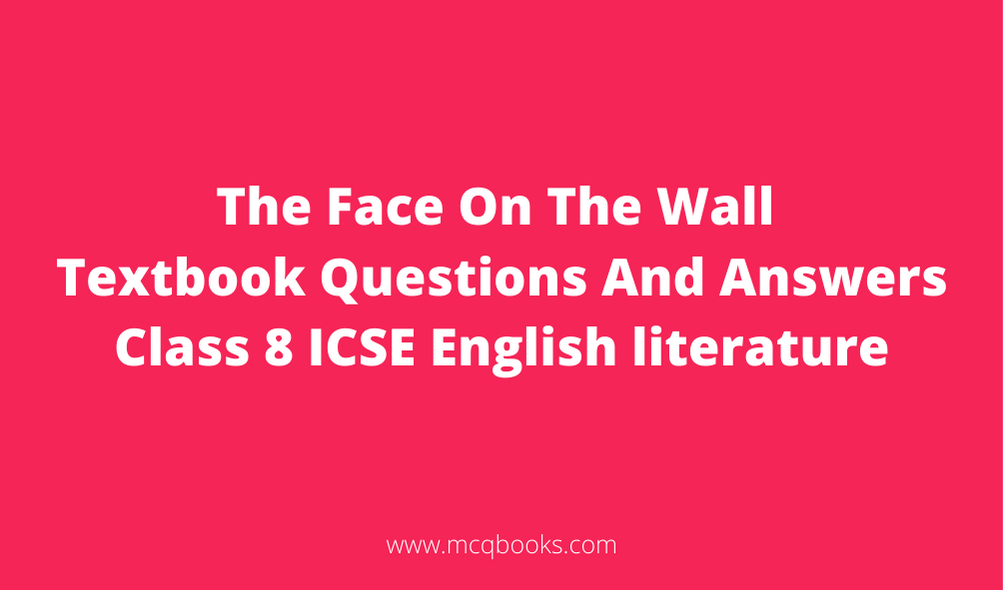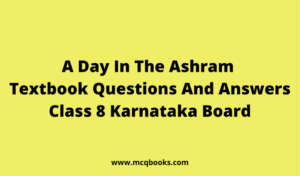The Face On The Wall Textbook Questions And Answers Class 8 ICSE English literature
English is a difficult subject for many people to learn. Some students may become frustrated and give up, but here’s The Face On The Wall Textbook Questions And Answers Class 8 ICSE English literature to help you maintain your momentum! The Face On The Wall Textbook Questions And Answers will provide all necessary information needed in order to study Class 8 ICSE English literature successfully at home or school; it includes detailed grammar rules with examples that were used during today’s class discussion on the ICSE Board English Exam.
The Face On The Wall Textbook Questions And Answers in English, ICSE Board Class 8 makes it easier to understand the story. Understanding every detail of a story is important for scoring higher on an exam and expert writers have made sure that you know how everything flows together by summarizing perfectly!

About the Author:
Edward Verrall Lucas was born in 1868 on the 11th or 12th of June in Eltham, Kent. He was educated at the Friends School. He belonged to a Quaker family. Also, he was a great English humorist, poet, novelist, and short story. Lucas joined the humorous magazine “Punch” in the year 1904 and worked there for the rest of his life. He wrote around 100 books.
Some of his great creations are “The Face on the Wall”, “Sparks from a Flint: Odd Rhymes for Odd Times” (1891), “A Book of Verse for Children” (1897), “The Flamp, the Ameliorator, and the Schoolboy’s Apprentice” (1897), “Traveller’s Joy” (1919), “Urbanities” (1921), “Michael Angelo” (1924) and a lot more.
Textbook Questions and Answers:
1. On which topic were the people at Dabney’s having a discussion?
Ans: At Dabney’s play, a discussion was happening about the events that were beyond scientific explanations and natural causes cannot explain that.
2. What kind of experience did the little man narrate?
Ans: The little man narrated his own experience. At that time, he was staying an old house in Great Ormond Street. The room he was staying in was damp and the walls were painted by the previous tenant. This one time he was suffering from influenza. He had once spotted a face with proper features appear on the wall of his room when he was staying there. That face had a firmer grip on him.
After he got better, he searched for that face everywhere. He finally found the man and realized his name was Mr Ormond Wall. The little man fainted and when he gained his senses, he was in a hospital in Boulogne. He went back to the old house and the next morning he found out in the headlines that Mr. Ormond was an American millionaire who had just met a motor accident and his condition was critical. The little man also noticed that the face on the wall had vanished.
3. What did the little man find on the wall of his room?
Ans: The little man found the face of a man on his wall. It had sharp features with a curved nose and a remarkable forehead.
4. What convinced the little man that a real man with a face like that on the wall existed? Where all did he try to look for that man?
Ans: The face on the wall made the little man very curious. He was somewhere convinced that such a man exists in reality. The face had a strange grip on him.
5. Where did he find the man, he was looking for? Why was he surprised to look at the visiting card of the man?
Ans: The little man was searching for that man everywhere. He found the man in a taxi driving east along Piccadilly. He began following the cab and reached Charing Cross. The man was standing there with a little girl and two women.
He was surprised when he saw the visiting card because it said Mr Ormond Wall. The house where he stayed was at Ormond street where he had spotted the face on the wall.
6. “I may say that it filled my thoughts day and night.”- Who is ‘I’ in this sentence? What is ‘it’ that filled the speaker’s thoughts? What kind of thoughts did ‘it’ fill the speaker’s mind with? Why did ‘it’ keep the speaker occupied ‘day and night’?
Ans: ‘I’ here is the little man who has been narrating the story.
The face of the man that was present on the wall of his room filled the speaker’s thoughts.
The little man wondered whose face it could be, for some reason he thought that such a man existed in reality. He would also think about the reason for the sudden appearance of such a thing.
Since the narrator confirmed that the face on the wall exists, he began searching for the face. He would do that all day and night.
7. “I never looked at women; …”- Who is the speaker in this sentence? Why did the speaker never look at women? Was the speaker looking for someone in particular? If yes, whom?
Ans: The speaker is the little man.
He wanted to find the man whose face appeared on his wall. Hence, He never felt like looking at women since he was always searching for that one man.
The speaker was looking for the man whose face had appeared on the wall of his room in that old house.
8. “Holding the card tight in my hand I hurried to a lonely corner of the ship and read it.”- Which card was the speaker holding in his hand? Why was the card important for the speaker? What was the speaker’s reaction after reading the card?
Ans: The speaker was holding the visiting card of the man (Mr Ormond Wall) whose face appeared through the patches of his wall.
The card was important for the speaker because he wanted to know the man’s identity because the man resembled the face on the wall.
The speaker was surprised and taken aback when he saw the card.
9. Which sentences suggest that the little man raised the curiosity of the listeners?
Ans: The following sentences suggest that the little man had raised the curiosity of the listeners:
“‘Most remarkable’, we said, ‘most extraordinary’, and so forth, and we meant it too.”
“Soon the narrator of the amazing experience rose up and said goodnight.”
These lines show how much the listeners were into the story and they loved the way it was narrated by the little man.
10. What did the disappearance of the face from the wall signify?
Ans: The disappearance meant that Mr Ormond Wall was no more and could not survive the motor accident.
11. What were the three most extraordinary things about the story the little man narrated?
Ans: The first extraordinary thing was that a simple patch on the wall can not only look so similar to a real person but also hold a deep significance in his life. Secondly, the name of the gentleman was similar to the name of the street where the old house was located. The third extraordinary thing was that the little man had made up the whole story just half an hour ago then.
12. Do you think the little man was an interesting storyteller? Why/ Why not?
Ans: The little man was indeed an interesting storyteller. He had kept everybody engaged in his story the whole time. He managed to keep the suspense although when he had just made up the story some time back.
13. Do you believe in the occurrences of incidences that cannot be supported by science or logic?
Ans: I am skeptical about occurrences of incidents that cannot be supported by science or logic. According to me, it is inappropriate to believe or disregard something completely without experiencing it.
Match the idioms in column A with their meanings in column B:
A B
Truth needs no colour Truth is truth; it needs no decoration.
Truth will out People will find out the truth even if you try to keep it secret.
Half the truth is often a whole lie If you don’t tell the complete truth, it is the same as telling a lie.
Liar is not believed when he tells the truth People will not believe anything a liar will say.
Bend the truth To suggest that something is not true.
Nothing could be further from the truth To say something that is not completely true.
Change the following into negative sentences without changing their meanings:
- Iron is a useful metal.
Iron is not a useless metal. - I am telling you the truth.
I am not lying to you. - The library is closed today.
The library is not open today. - I am feeling very cold today.
I am not feeling warm today - The food at the restaurant was good.
The food at the restaurant was not bad. - She was annoyed with his behavior today.
She was not impressed with his behavior today.
Transform the following sentences:
- We walk along the shorter lane to school. (Rewrite the sentence using ‘not’.)
We do not walk along the longer lane to school. - Drink your milk. (Rewrite the sentence starting with ‘can’ or ‘will’.)
Can you drink your milk? - Didn’t you like my suggestion? (Rewrite the sentence starting with ‘you’.)
You did not like my suggestion, did you? - It is so much fun to work on the project together. (Rewrite the sentence using an exclamation mark.)
How fun is it to work on the project together! - Are we on time for the match? (Rewrite the sentence starting with ‘we’.)
We are on time for the match, aren’t we? - Why don’t you shut the window? (Rewrite the sentence starting with ‘shut’.)
Shut the window. - He is not a smart and intelligent boy. (Rewrite the sentence starting with ‘is’.)
Is he a smart and intelligent boy? - How nice of you to come to the party! (Rewrite the sentence starting with ‘it’.)
It is nice that you came to the party.
Add suitable question tags to the statements:
- Push this sofa.
Push this sofa, can’t you? - Let’s clean this room.
Let’s clean this room, won’t you? - You have not finished your work.
You have not finished your work, have you? - Everybody should help the poor.
Everybody should help the poor, shouldn’t they? - You are not wearing this dress for the party.
You are not wearing this dress for the party, are you? - All your life you have lived in the mountains.
All your life you have lived in the mountains, haven’t you?
Identify whether each highlighted phrase is a noun phrase (N), an adjective phrase (A) or an adverb phrase (AV):
- We must go and meet our new neighbors. – N
- She opened all the boxes very carefully. – AV
- The dining room was decorated with balloons. – N
- He crawled on his hands and knees. – N
- I’m extremely excited about the school trip. – A
- The dog running after the car is mine. – N
Replace the underlined adjective phrases with suitable adjectives:
- She likes wearing dresses made of silk.
She likes wearing silk-made dresses. - There are many houses in the mountains made of wood.
There are many wooden houses in the mountains. - The robbers took away all the jewelry made of gold.
The robbers took away all the gold-made jewellery. - An author from America has written this book.
An American author has written this book. - He was chased by a dog that was angry.
He was chased by an angry dog.
Complete these sentences with suitable phrases as directed:
- Have you read that new book? (noun phrase)
- The birds fly near that tree in the evening. (adverb phrase)
- The pool where I swim is very large. (adjective phrase)
- Do you have a book that has a happy plot? (adjective phrase)
- Can you please tell me if you know him? (noun phrase)
- They will work very carefully to complete the decorations. (adverb phrase)
Questions And Answers
What is the summary of the story of the face on the wall?
The Face on the Wall narrates the experience of a guest who was staying in Great Ormond Street in an old house. During one such stay, he noticed the damp walls had discolored patches on them. One particular patch resembled a human face. The guest becomes obsessed with the face.
What happened to the face on the wall?
The face on the wall was faint when Mr Ormond had an accident and disappeared when he died. He finished talking and when he was at the door, the people in the room reminded him of the third thing.
What is the theme of the story the face on the wall?
The reason growing up involves facing tough situations is a good theme for the story is because everyone has changed in life and life doesn’t always go the way you want it to go. Children every day have to experience growing up as a part of their lives.
What were the three remarkable things about the story of the face on the wall?
The storyteller said that there were three extraordinary things about this story. First, the face on the wall in the room looked like the face of a true American gentleman and the man’s name had a relation to the place Ormond Street. Second, the face on the wall was faint when Mr.
What was the surprise element of the story face on the wall?
One particular patch resembled a human’s face. The guest becomes obsessed with the face and inquires to reveal that it is the face of the American Millionaire Ormand wall. The guest recalled the face was slightly visible when he woke up the previous morning. By evening, they had disappeared completely.
What happened to the face on the wall when the narrator went back home?
The narrator reached his city and slept at night. But in the morning, he saw that the face on the wall had become dim. The next morning it disappeared from the wall.




